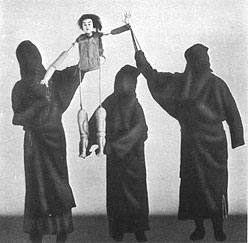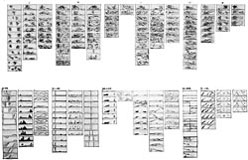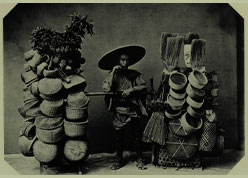
The Society for International Cultural Relations, Tokyo, 1935

[ + ] POP-UP LARGE
THE CIVIL WARS: THE AMERICAN SECTION
Einstein on the Beach, the 1976 landmark music/theater collaboration with composer Philip Glass, was shorter by comparison, lasting slightly longer than five hours. But its elaborate scenery and prop changes that took several minutes to accomplish required a new technique to maintain the continuous flow of time. The four acts were drawn together by Wilson’s first use of knee plays. They were performed by Sheryl Sutton and Lucinda Childs in a small quadrant at downstage left.
The staging of the Knee Plays for the CIVIL warS is more complex, utilizing the full stage width, eight dancers and a separate music ensemble. Its structure draws liberally from conventions of Asian theater, particularly those of Japanese Kabuki, Noh and Bunraku. But while it is informed by these structures it is characteristically Wilson’s: flowing naturally in his poetic and imagistic theater.
The Process
Maita di Niscemi, co-librettist with Wilson for the Rome section observes in her contribution to that production’s catalogue, “the manner in which [the work] was created is fascinating because, in a sense, it was written backwards. First came the drawings.” Wilson’s works for the theater are most importantly visual. Sketches, drawn repeatedly, affirm the sense and form of the work. Wilson’s rapid, automatistic execution of them suggests that the action of drawing is the process of thinking, that they are pictographs which form and communicate his ideas. Through them the stories unfold, movement is suggested and lighting is conceived in broad swatches of charcoal.
Drawings both precede and follow the realization of a performance. They are idealizations which reveal the relationship of forms which appear at the picture plane of his proscenium. Multiple drawings do not offer construction details, yet the final results of the stage event often closely resemble the charcoal, ink and graphite renderings in essence and energy.
For each section, and for the production as a whole, the process developing the stage work begins with intensive workshop programs attended by actors, the composer and technicians. The first sessions which served to create the form and direction for the CIVIL warS took place in Munich in August, 1981 and later in Freiburg in June, 1982. Robert Wilson and David Byrne first met in Tokyo in 1981 and discussed the possibility of collaborating on the CIVIL warS. Later, the first workshop for the Knee Plays and the Japan section was held in April of 1983 in Tokyo. David Byrne joined in this workshop and began writing music for the plays. Also attending the creative session were Adelle Lutz, who has served as a major artistic collaborator; Hideo Kanze, leader of one of the foremost schools of Noh theater; and members of the Waseda Sho-gekijo, a preeminent ensemble of vanguard Japanese theater artists.
During this workshop, the concept for the Knee Plays was formed by Wilson, Byrne and Lutz. They envisioned a succession of events staged by adapting the Bunraku puppet theater technique of actors or dancers who manipulate the objects on stage. The musicians, too, would conform to the Bunraku tradition by taking positions at stage left. The Tokyo workshop developed five of the thirteen knee plays which were presented in a public rehearsal at the workshop’s warehouse studio near Tokyo Bay.
